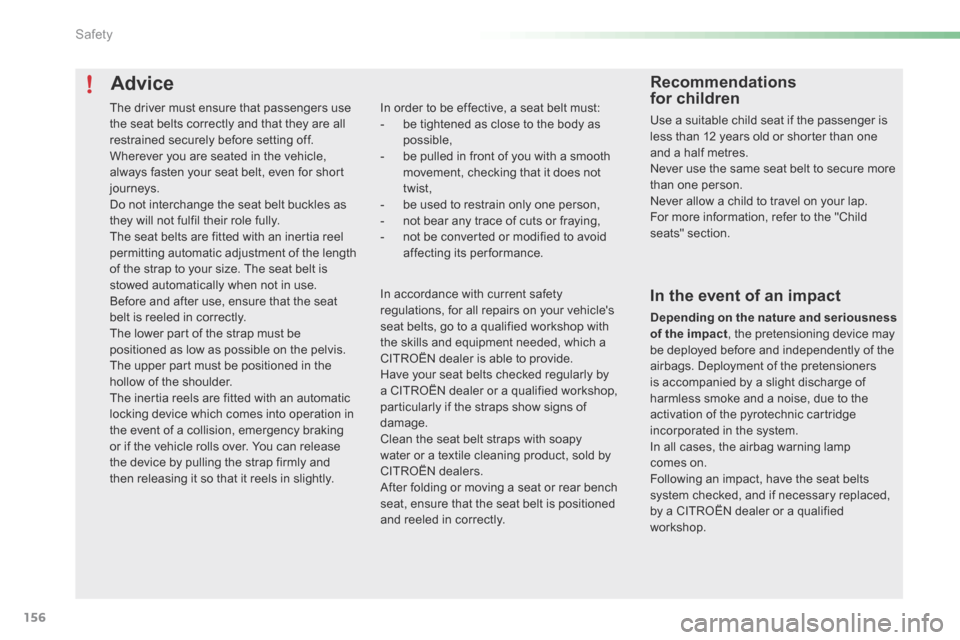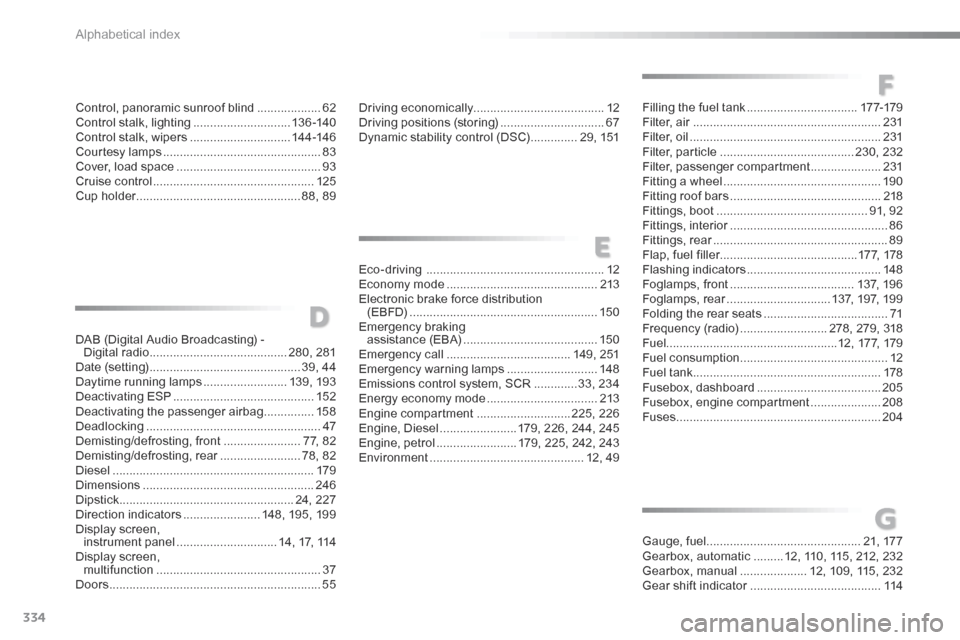fold seats Citroen C5 2016 (RD/TD) / 2.G Owner's Manual
[x] Cancel search | Manufacturer: CITROEN, Model Year: 2016, Model line: C5, Model: Citroen C5 2016 (RD/TD) / 2.GPages: 366, PDF Size: 30.93 MB
Page 60 of 366

58
C5_en_Chap02_ouverture_ed01-2015
Boot (Saloon)
F Press upwards on lever 1 and lift up the
boot lid. With the vehicle stationary, this is carried out
using:
-
The remote control.
- The key in a door lock.
- The interior central locking/ unlocking control.
The boot automatically locks when the vehicle
is moving at a speed of over 6 mph (10 km/h),
even if automatic central locking is deactivated.
It is unlocked when a door is opened or when
the central locking button is pressed (speed
lower than 6 mph (10 km/h)).
Opening Locking/unlocking Emergency boot release
Unlocking
F Fold back the rear seats to gain access to
the lock from inside the boot.
F Insert a small screwdriver into hole A of the
lock to unlock the tailgate.
F Push the white part, located inside the
lock, to the left to unlock the boot.
System for mechanical unlocking of the boot
in the event of a battery or central locking
malfunction.
access
Page 73 of 366

71
C5_en_Chap03_ergo-et-confort_ed01-2015
Rear head restraints
The rear head restraints can be removed and
have two positions:
- high, position for use,
- low, storage position.
To raise a head restraint, pull it upwards.
To lower it, press the lug then the head
restraint.
To remove it, place it in the high position, push
the lug and pull it upwards.
To refit it, engage the head restraint rods in the
holes taking care to remain in line with the seat
back.
Rear seats
Bench seat, the left-hand (2/3) or right-hand (1/3) section of which can be folded to adapt the boot load space.
In order to fold a rear seat without any risk of
damage, always start with the seat cushion,
never with the seat backrest:
F Move the corresponding front seat for ward
if necessary.
F Raise the front of the seat cushion 1 .
F Tilt the seat cushion 1 fully against the front
seat.
F Check that the seat belt is positioned
correctly on the side of the seat backrest.
F Lower or remove the head restraints if
necessary.
Folding the seat
F Pull the control 2 for ward to release the
seat backrest 3 .
F Fold the seat backrest 3 fully down.
n ever drive with the head restraints
removed, they must be in place and
correctly adjusted. The seat cushion 1 can be removed to
increase the load volume.
3
Ease of use and comfort
Page 96 of 366

94
C5_en_Chap03_ergo-et-confort_ed01-2015
High load retaining net
(Tourer)
Hooked onto the special upper and lower
fixings, this permits use of the entire loading
volume up to the roof:
- behind the rear seats (row 2),
- behind the front seats (row 1) when the rear
seats are folded.
When positioning the net, check that the strap
loops are visible from the boot; this will make
slackening or tightening easier.
Installation
F Fold down the backrests of the rear seats.
F Position the high load retaining net roller
above the two rails 1 located behind the
rear seats (2/3 bench seat). The two
notches 2 must be placed above the
two rails. F
Slide the two rails 1 into the notches 2 and
push the roller (lengthways) from right to
left to secure it.
F Reposition the rear seat backrests.
Ease of use and comfort
Page 97 of 366

95
C5_en_Chap03_ergo-et-confort_ed01-2015
Row 1
To use it in row 1:
F fold down the backrests of the rear seats,
F open the covers 3 of the corresponding
upper fixings,
F unroll the high load retaining net and
position one of the ends of the net's metal
bar in the corresponding fixing cover.
Check that the hook is secured in the rail
located inside the cover 3 ,
F pull the high load retaining net's metal bar
to position the other hook in the second
fixing cover.
Row 2
To use it in row 2:
F open the covers 4 of the corresponding
upper fixings,
F from the rear bench seat, unroll the high
load retaining net, pushing it to detach it
from the retaining hooks,
F position one of the ends of the net's metal
bar in the corresponding fixing cover.
Check that the hook is secured in the rail,
located inside the cover 4 ,
F position the other hook in the second fixing
cover and pull the metal bar towards you.
3
Ease of use and comfort
Page 158 of 366

156
C5_en_Chap06_securite_ed01-2015
Advice
In order to be effective, a seat belt must:
- be tightened as close to the body as
possible,
- be pulled in front of you with a smooth
movement, checking that it does not
twist,
- be used to restrain only one person,
- not bear any trace of cuts or fraying,
- not be converted or modified to avoid
affecting its performance.
Recommendations
for children
Use a suitable child seat if the passenger is
less than 12 years old or shorter than one
and a half metres.
Never use the same seat belt to secure more
than one person.
Never allow a child to travel on your lap.
For more information, refer to the "Child
seats" section.
In accordance with current safety
regulations, for all repairs on your vehicle's
seat belts, go to a qualified workshop with
the skills and equipment needed, which a
CITROËN dealer is able to provide.
Have your seat belts checked regularly by
a CITROËN dealer or a qualified workshop,
particularly if the straps show signs of
damage.
Clean the seat belt straps with soapy
water or a textile cleaning product, sold by
CITROËN dealers.
After folding or moving a seat or rear bench
seat, ensure that the seat belt is positioned
and reeled in correctly.
In the event of an impact
Depending on the nature and seriousness
of the impact , the pretensioning device may
be deployed before and independently of the
airbags. Deployment of the pretensioners
is accompanied by a slight discharge of
harmless smoke and a noise, due to the
activation of the pyrotechnic cartridge
incorporated in the system.
In all cases, the airbag warning lamp
comes on.
Following an impact, have the seat belts
system checked, and if necessary replaced,
by a CITROËN dealer or a qualified
workshop.
The driver must ensure that passengers use
the seat belts correctly and that they are all
restrained securely before setting off.
Wherever you are seated in the vehicle,
always fasten your seat belt, even for short
journeys.
Do not interchange the seat belt buckles as
they will not fulfil their role fully.
The seat belts are fitted with an inertia reel
permitting automatic adjustment of the length
of the strap to your size. The seat belt is
stowed automatically when not in use.
b
efore and after use, ensure that the seat
belt is reeled in correctly.
The lower part of the strap must be
positioned as low as possible on the pelvis.
The upper part must be positioned in the
hollow of the shoulder.
The inertia reels are fitted with an automatic
locking device which comes into operation in
the event of a collision, emergency braking
or if the vehicle rolls over. You can release
the device by pulling the strap firmly and
then releasing it so that it reels in slightly.
Safety
Page 336 of 366

334
C5_en_Chap12_index-alpha_ed01-2015
Filling the fuel tank ................................. 17 7-179
Filter, air ........................................................ 231
Filter, oil ......................................................... 231
Filter, particle ........................................ 230, 232
Filter, passenger compartment ..................... 231
Fitting a wheel ............................................... 19 0
Fitting roof bars ............................................. 218
Fittings, boot ............................................. 91, 92
Fittings, interior ............................................... 86
Fittings, rear .................................................... 89
Flap, fuel filler ......................................... 17 7, 178
Flashing indicators ........................................ 148
Foglamps, front ..................................... 137, 196
Foglamps, rear ............................... 137, 197, 199
Folding the rear seats ..................................... 71
Frequency (radio) ..........................278, 279, 318
Fuel ................................................... 12, 177, 179
Fuel consumption ............................................ 12
Fuel tank ........................................................ 178
Fusebox, dashboard ..................................... 205
Fusebox, engine compartment ..................... 208
Fuses ............................................................. 204
Driving economically
....................................... 12
Driving positions (storing) ...............................67
Dynamic stability control (DSC) ..............29, 151
Eco-driving ..................................................... 12
Economy mode ............................................. 213
Electronic brake force distribution (EBFD) ........................................................ 150
Emergency braking
assistance (EBA) ........................................ 150
Emergency call ..................................... 149, 251
Emergency warning lamps ........................... 148
Emissions control system, SCR .............33, 234
Energy economy mode .................................213
Engine compartment ............................ 225, 226
Engine, Diesel .......................179, 226, 244, 245
Engine, petrol ........................ 179, 225, 242, 243
Environment .............................................. 12, 49
Gauge, fuel .............................................. 21, 177
Gearbox, automatic .........12, 110, 115, 212, 232
Gearbox, manual .................... 12, 109, 115, 232
Gear shift indicator ....................................... 114
DAB (Digital Audio Broadcasting) -
Digital radio ......................................... 280, 281
Date (setting) ............................................. 39, 44
Daytime running lamps .........................139, 193
Deactivating ESP .......................................... 152
Deactivating the passenger airbag ............... 15 8
Deadlocking .................................................... 47
Demisting/defrosting, front ....................... 77, 82
Demisting/defrosting, rear ........................ 78, 82
d iesel ............................................................ 179
Dimensions ................................................... 246
Dipstick .................................................... 24, 227
d irection indicators ....................... 148, 195, 199
d isplay screen,
instrument panel .............................. 14, 17, 114
d isplay screen,
multifunction ................................................. 37
d oors ............................................................... 55
E
F
G
D
Control, panoramic sunroof blind ...................62
Control stalk, lighting .............................13 6 -14 0
Control stalk, wipers ..............................14 4 -146
Courtesy lamps ............................................... 83
Cover, load space ........................................... 93
Cruise control ................................................ 125
Cup holder ................................................. 88, 89
alphabetical index